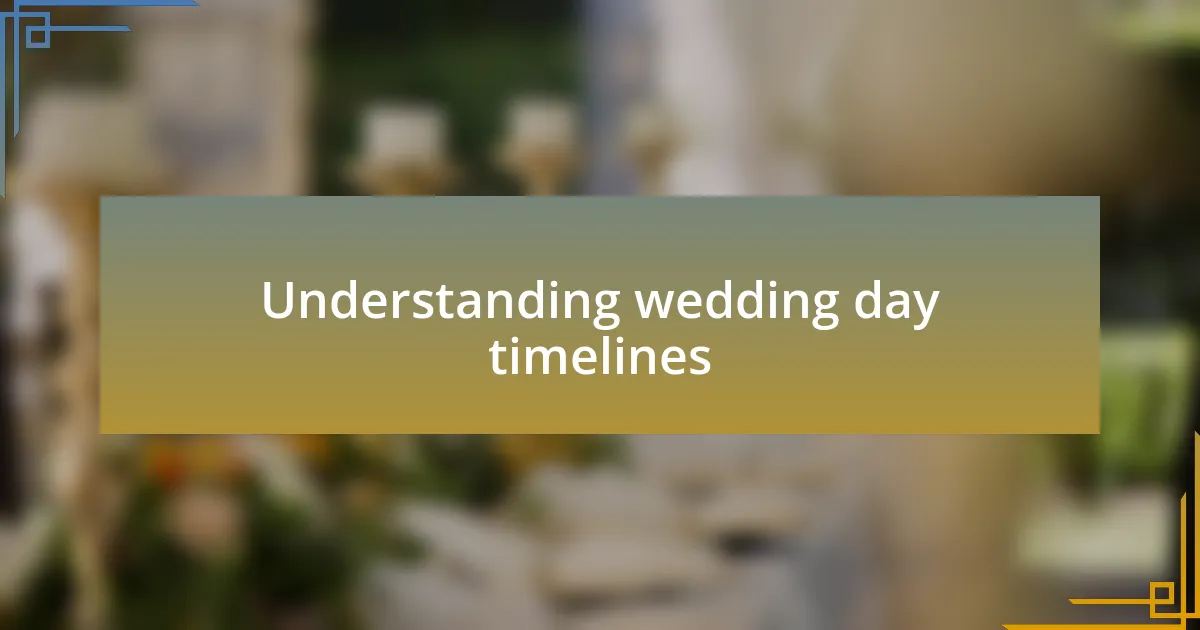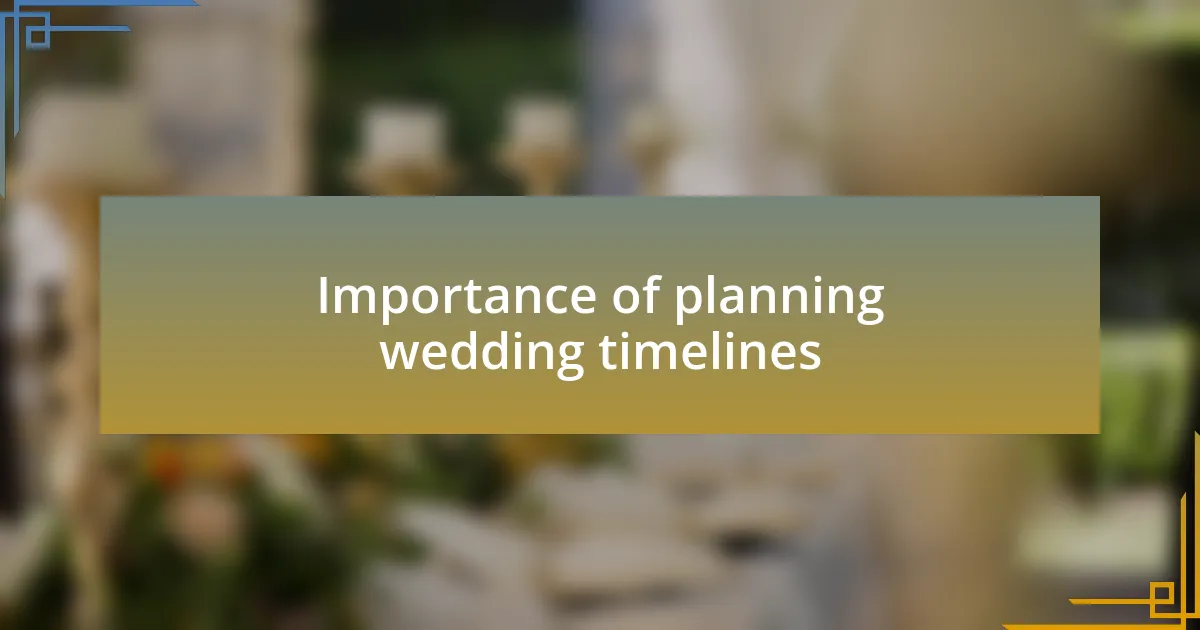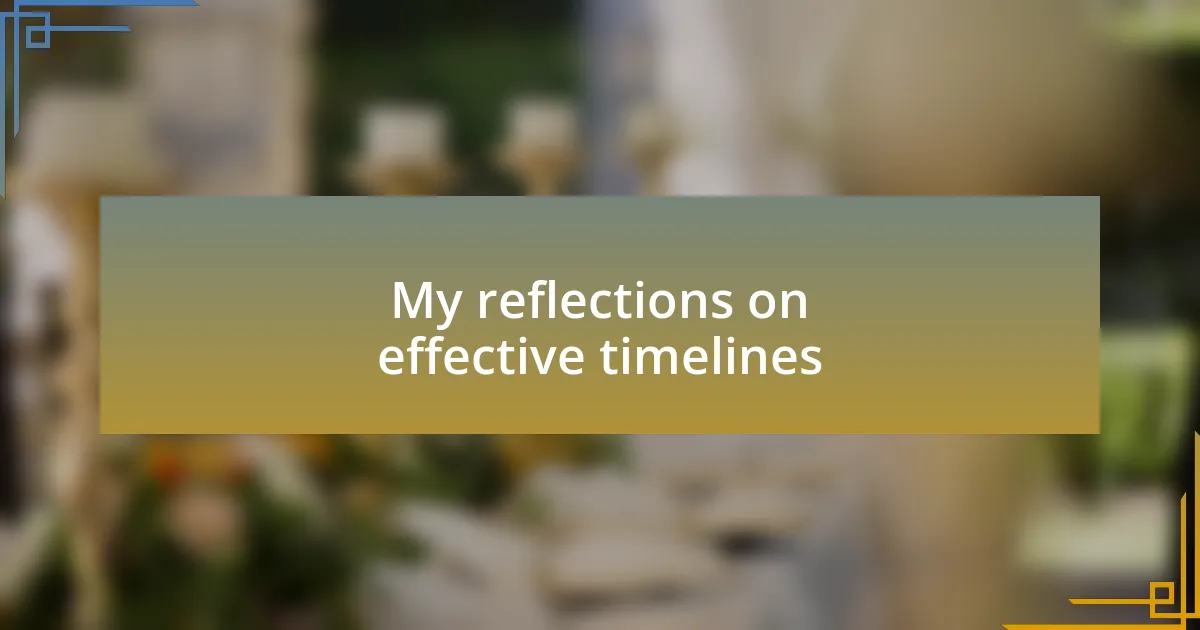Key takeaways:
- Creating a wedding day timeline enhances the experience by allowing for meaningful pauses and flexibility.
- Allocating time for candid photos fosters connections with family and friends while capturing genuine emotions.
- Personalizing the schedule with unique elements, like favorite songs, elevates the atmosphere and reflects the couple’s love story.
- Incorporating buffer zones in the timeline reduces stress and encourages a relaxed, joyful environment for everyone involved.

Understanding wedding day timelines
When I first started planning my wedding, the timeline felt daunting. I realized that understanding how much time I needed for each segment, from hair and makeup to the ceremony and reception, was crucial for a smooth day. Have you considered how little moments can add up to a meaningful experience?
Creating a wedding day timeline isn’t just about scheduling; it’s about crafting a narrative. I remember carefully mapping out when I’d see my partner for the first time, wanting to ensure the anticipation built to that beautiful moment. Don’t underestimate how significant those little pauses can be—these precious minutes add emotion and depth to your day.
I found that being flexible with the timeline can actually enhance the experience. As I adjusted times here and there, I felt more relaxed, allowing me to enjoy the day instead of rushing through it. Have you thought about how it might feel to flow with the day, rather than fight against the clock? Embracing the unexpected can lead to some of the most memorable moments.

Importance of planning wedding timelines
When I sat down to finalize our wedding timeline, I remember feeling a mix of excitement and anxiety. Each moment meticulously planned meant that we could savor our big day without scrambling last minute. Have you ever tried to enjoy an event while worrying that you’re running behind? A solid timeline alleviates that stress, allowing you to focus on what truly matters—making memories.
One remarkable aspect of our timeline was allocating time for candid photos between the ceremony and reception. For me, those moments were more than just pictures; they became opportunities to connect with family and friends. Have you considered how capturing genuine emotions can transform your wedding album? Having that dedicated time not only added depth to our photos but also gave me a moment to breathe and appreciate everything happening around me.
I learned that planning the timeline isn’t just a logistical task; it’s about setting the tone for the day. On my wedding day, the moments we planned to pause became highlights of the event. Did you ever think about how pauses can create spaces for joy? Those intentional breaks helped us soak in the experience, making it feel less like a checklist and more like a celebration of love.

Personalizing your wedding day schedule
Personalizing your wedding day schedule allows you to tailor your big day to reflect your unique love story. I vividly remember integrating elements like our favorite songs during the pre-ceremony music. Did you know that music can set the emotional tone for your event? It made such a difference in creating the atmosphere as our guests mingled, making our wedding feel authentically us.
One of the best decisions I made was to prioritize moments that were meaningful to us. During our planning, we included a specific time for a private cake-cutting session before the reception. Imagine stepping away from the lively crowd for just a moment, savoring the sweetness of the cake together—it was intimate and special. Have you thought about what small, personal moments could elevate your day?
While drafting the timeline, I encouraged a flexible approach. For example, instead of rigidly sticking to the clock, we kept slots open for spontaneous moments, like dancing before dinner. I found this flexibility allowed us to immerse ourselves in the joy of the day without feeling rushed. Isn’t it liberating to think that your schedule can evolve naturally, embracing the unexpected while still honoring your plan?

My reflections on effective timelines
When I think about effective timelines, I recall how crucial it was to consider not just the events but the emotions tied to them. For instance, we allocated an hour for our first look before the ceremony, and that moment turned out to be an emotional highlight. Have you ever experienced a moment where time seemed to stand still? It felt like our own little world, away from the hustle of wedding preparations, deepening our connection right before saying “I do.”
One aspect I learned about creating a timeline is the power of buffer zones. Initially, I packed our schedule tightly with events, thinking that efficiency was key. However, I quickly realized that giving ourselves extra time between key moments allowed us to breathe and savor each experience fully. When I look back, those few extra minutes made it possible to share laughs with my bridal party, creating a relaxed atmosphere that left us all feeling joyful and connected. What will you do to ensure your day unfolds without unnecessary stress?
Reflecting on the importance of guest engagement in our timeline makes me smile. We arranged interactive moments, like a photo booth during cocktail hour, which encouraged guests to mingle and have fun. I still chuckle at the goofy pictures we received afterward! How are you planning to create engaging experiences for your guests? Designing a timeline that invites participation transforms your wedding from just a ceremony into an unforgettable celebration for everyone involved.